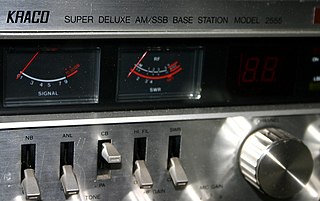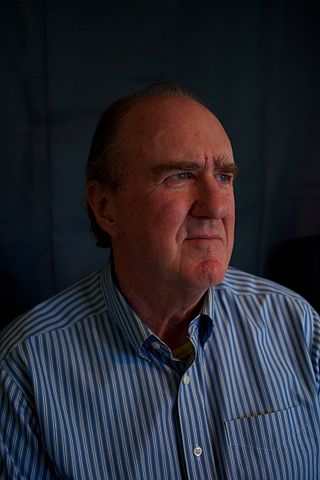
Vehicle audio is equipment installed in a car or other vehicle to provide in-car entertainment and information for the occupants. Until the 1950s, it consisted of a simple AM radio. Additions since then have included FM radio (1952), 8-track tape players, cassette players, record players, CD players, DVD players, Blu-ray players, navigation systems, Bluetooth telephone integration and audio streaming, and smartphone controllers like CarPlay and Android Auto. Once controlled from the dashboard with a few buttons, they can be controlled by steering wheel controls and voice commands.
The automotive aftermarket is the secondary parts market of the automotive industry, concerned with the manufacturing, remanufacturing, distribution, retailing, and installation of all vehicle parts, chemicals, equipment, and accessories, after the sale of the automobile by the original equipment manufacturer (OEM) to the consumer. The parts, accessories, etc. for sale may or may not be manufactured by the OEM.
Blaupunkt GmbH was a German manufacturer, producing mostly car-audio gear and other electronic equipment. Owned by Robert Bosch GmbH from 1933 until 1 March 2009, it was sold to Aurelius AG of Germany. It filed for bankruptcy in late 2015 with liquidation proceedings completed in early 2016. The brand, now managed by GIP Development SARL of Luxembourg, is licensed for use by various product groups worldwide.

Kenwood is a Japanese brand for consumer electronics. Since October 2011, Kenwood has been owned by JVCKenwood as a result of a merger between Kenwood Corporation and JVC. Kenwood manufactures audio equipment such as AM/FM stereo receivers, cassette tape decks/recorders, amateur radio (ham) equipment, radios, cellular phones, speakers, and other consumer electronics.

JBL is an American audio equipment manufacturer headquartered in Los Angeles, California. The company was founded in 1946 by James Bullough Lansing, an American audio engineer and loudspeaker designer. JBL currently serves the home and professional audio markets. Their professional products include live PA systems, studio monitors, and loudspeakers for cinema. Their home products include home audio speakers, waterproof Bluetooth speakers, and high-end car audio. JBL is owned by Harman International, a subsidiary of Samsung Electronics.
Altec Lansing, Inc. is an American audio electronics company founded in 1927. Their primary products are loudspeakers and associated audio electronics for professional, home, automotive and multimedia applications.
Henry Kloss was a prominent American audio engineer and entrepreneur who helped advance high fidelity loudspeaker and radio receiver technology beginning in the 1950s. Kloss was an undergraduate student in physics at the Massachusetts Institute of Technology, but never received a degree. He was responsible for a number of innovations, including, in part, the acoustic suspension loudspeaker and the high fidelity cassette deck. In 2000, Kloss was one of the first inductees into the Consumer Electronics Association's Hall of Fame. He earned an Emmy Award for his development of a projection television system, the Advent VideoBeam 1000.

Hella GmbH & Co. KGaA is an internationally operating German automotive parts supplier headquartered in Lippstadt, North Rhine-Westphalia. The company develops and manufactures lighting, electronic components, and systems for the automotive industry. It also operates one of the largest trade organizations for automotive parts, accessories, diagnostics, and services within Europe.
James Bullough Lansing was a pioneering American audio engineer and loudspeaker designer who was most notable for establishing two audio companies that bear his name, Altec Lansing and JBL, the latter taken from his initials, JBL.

Monsoon is a brand of loudspeakers, originally automotive speaker systems and later computer speakers. Monsoon was originally associated with OEM-sourced automotive audio speaker systems, notably supplied on a number of General Motors products and then later expanded onto other manufacturers such as Volkswagen. The brand name was also licensed to Sonigistix, a Richmond, B.C., Canada company, and applied to their line of computer multimedia speakers.

Studio monitors are loudspeakers in speaker enclosures specifically designed for professional audio production applications, such as recording studios, filmmaking, television studios, radio studios and project or home studios, where accurate audio reproduction is crucial. Among audio engineers, the term monitor implies that the speaker is designed to produce relatively flat (linear) phase and frequency responses. In other words, it exhibits minimal emphasis or de-emphasis of particular frequencies, the loudspeaker gives an accurate reproduction of the tonal qualities of the source audio, and there will be no relative phase shift of particular frequencies—meaning no distortion in sound-stage perspective for stereo recordings. Beyond stereo sound-stage requirements, a linear phase response helps impulse response remain true to source without encountering "smearing". An unqualified reference to a monitor often refers to a near-field design. This is a speaker small enough to sit on a stand or desk in proximity to the listener, so that most of the sound that the listener hears is coming directly from the speaker, rather than reflecting off walls and ceilings. Monitor speakers may include more than one type of driver or, for monitoring low-frequency sounds, such as bass drum, additional subwoofer cabinets may be used.

BBS Autotechnik GmbH, formerly known as BBS Kraftfahrzeugtechnik AG, is a high-performance automobile wheel design company headquartered in Schiltach, Germany. BBS produces wheels for motorsport, OEM, and aftermarket applications. The company is often credited as pioneering the three-piece wheel and advancing the aluminum wheel industry over many decades, and remains one of the largest producers of automobile wheels in the world. It is a part of KW Automotive since 2021.

Kraco Enterprises, LLC, is an American private company. It primarily manufactures fabricated rubber products for a wide variety of purposes and applications. While they mainly produce floormats, they have also been a supplier for the automotive industry producing tire walls and even audio equipment including car speakers, stereos, and CB radios. Kraco was founded in 1954 in Compton, California. Their first product was "Snap-on" white walls to create temporary white-walled tires. They moved into making rubber, vinyl and soon thereafter, carpet floormats as the business expanded.
A coaxial loudspeaker is a loudspeaker system in which the individual driver units radiate sound from the same point or axis. Two general types exist: one is a compact design using two or three speaker drivers, usually in car audio, and the other is a two-way high-power design for professional audio, also known as single-source or dual-concentric loudspeakers. The design is favored for its compactness and behavior as an audio point source.

A soundbar, sound bar or media bar is a type of loudspeaker that projects audio from a wide enclosure. It is much wider than it is tall, partly for acoustic reasons, and partly so it can be mounted above or below a display device. In a soundbar, multiple speakers are placed in a single cabinet, which helps to create stereo sound and surround sound effect. A separate subwoofer is typically included with, or may be used to supplement, a soundbar.

DUPLEX was the trade name given by Altec Lansing to its line of coaxial loudspeakers, beginning with the first model 601 in 1943. However, the name was most commonly associated with the subsequent model 604 which was a seminal loudspeaker that became a milestone in loudspeaker development. Well over a dozen different models carried the Duplex name over a near 50-year period. The vast majority consisted of a high frequency (HF) compression driver mounted to the back of a large diameter paper cone low frequency (LF) driver. However, there were also a few models with small diameter LF cones and direct radiator tweeters.

Cliff Henricksen is a musician, inventor and audio technologist. He is self-taught as a musician with a graduate degree in mechanical engineering at Massachusetts Institute of Technology (MIT). Throughout his career Cliff has found innovative ways to apply engineering basics to electro acoustics and to audio technology as it applies to music and in particular to live music performance. He has invented and engineered a wide variety of technologies and products well known in the world of professional audio. Today he balances work in audio and work as a performing musician.

Charles Emory Hughes II is an American inventor and audio engineer. He is known for his work on loudspeaker design, and the measurement of professional audio sound systems. Hughes first worked for Peavey Electronics designing loudspeakers and horns where he was granted a patent for the Quadratic-Throat Waveguide horn used in concert loudspeakers. He worked for Altec Lansing for two years as chief engineer for the pro audio division and was granted two more patents. In 2021, Hughes was hired by Biamp as principal engineer.
Vifa is a brand name used by Danish company Vifa Denmark A/S. In everyday speech, the brand name also refers to the company itself. The company designs and manufactures consumer and professional audio products.











